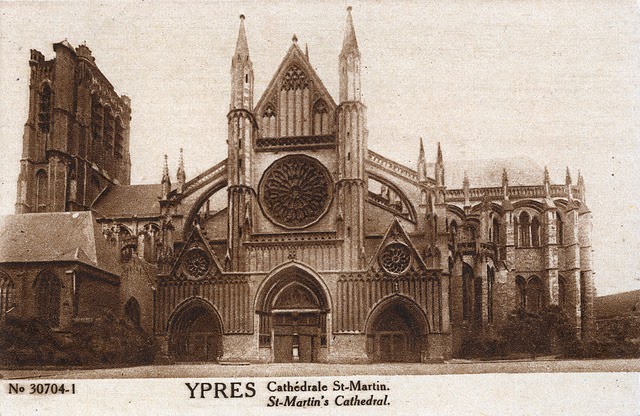Medieval
Europe was plagued by many wars that wreaked destruction and death throughout
the land. This pattern continued well after the end of the medieval period. Through
all these wars, armies left standing many grand and magnificent medieval Gothic
cathedrals and structures. This sense of honorable warfare came to an end with
the start of the Great War in 1914. From England and Spain in the west to
Russia in the east, there was not any war that would bring such destruction
upon Europe, let alone to its cathedrals. A prime example of the destruction is
the story of the cathedral at Ypres, Belgium, commonly known as Saint Martin’s
Cathedral.
 |
| St. Martin's Cathedral, Ypres, Belgium. Notice the rose mirror and lofty heights. |
 |
| Interior of Cathedral. Notice the stained glass all the way around. |
Construction
for St. Martin’s, which originally started out as a large church and not a
cathedral, began in 1230 and wasn’t finished until 1370. Standing 335 feet
high, St. Martin’s had many of the common components (according to Judith
Bennett) of Gothic architecture: pointed archways, stained glass, rose windows,
and flying buttresses. Originally a part of the Diocese of Therouanne, the
church at Ypres served the community in the prosperous region of modern day
Belgium. The church was promoted to cathedral status in the 16th
century following the razing of Therouanne, and the following reform that
abolished the previous diocese. Ypres became its own diocese and the church
became St. Martin’s Cathedral. This status would remain until 1801 with the
Concordant between Napoleon Bonaparte and Pope Pious VII which incorporated the
Diocese of Ypres into the Diocese of Ghent.
 |
| Ruins of the Cathedral during WWI |
Just
as Bennett discusses, the relatively thin tall walls supported by their flying
buttresses, stood strong against weather and time. However they could not hold
up to the pounding of shells and explosions from German artillery in World War
One. The scene of trench warfare, the city of Ypres and St. Martin’s was
devastated and nearly completely leveled.
Following the war, the ruins of St.
Martin’s was removed and rebuilt following the original plans except for a higher
spire on the tower.
 |
 |
| Original Cathedral prior to the war. Notice that there is no spire on the tower to the left. |
For
more information regarding St. Martin’s Cathedral:
http://www.dailymail.co.uk/news/article-2282108/World-War-One-wasteland-Haunting-rare-images-apocalyptic-destruction-Western-Front.html (this one has some fascinating, and shocking,
photos of St. Martin’s and Ypres after WWI)
Additional
Reading on Gothic cathedrals:
Judith
Bennett’s Medieval Europe: A Short History, p. 292-296
 |
| Before & After Photos of the interior of the Cathedral |



